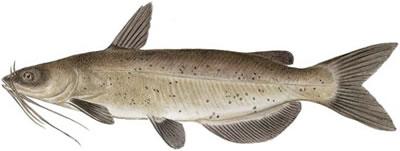The most widely distributed of all freshwater catfish, the channel cat is a significant component of recreational angling efforts, as well as a mainstay of commercial fishing; its tender, white, and nutritious flesh is highly valued as table fare. It has been stocked widely in lakes and ponds, and provides the backbone of catfish farming activities.
In some states, the sporty channel cat is ranked at or near the top among all species in angling popularity. Channel catfish have the potential to attain large sizes, although less gargantuan than other species, but their general willingness to strike baits, their wide distribution, and their high food esteem primarily account for their popularity.
Identification
Channel catfish are often recognized at a glance, owing to their deeply forked tails and small irregular spots on the sides. The spots may not be present in all specimens but generally are obvious in smaller individuals. These pigmented spots are most noticeable on younger fish and obscure on older ones. |
 |
The blue catfish also has a forked tail but no spots, and the same is true for the Yaqui catfish (Ictalurus pricei; a species in the Yaqui River drainage of Mexico). The channel cat is more slender than other catfish, perhaps owing to its native riverine existence, and it has a relatively small head. It is distinguished from the white and the blue catfish by its 24 to 29 anal fin rays.
The body of a channel catfish is pale blue to pale olive with a bit of silvery tint, but the color variation is subject to location and water conditions. Male channel cats during the spawning season may be entirely black dorsally, and other channel cats may be dark blue, with little or no spotting, or uniformly light blue or silvery, like the blue catfish or the white catfish. Another feature distinguishing a channel catfish from a blue catfish is the anal fin; this is shorter and more rounded on a channel catfish than on a blue catfish.
Like other catfish, channel cats have heavy, sharp pectoral and dorsal spines, as well as long mouth barbels.
Size/Age
The maximum age for these fish varies by latitude; some fisheries sources report a maximum longevity of 15 to 20 years, although it is believed their age can exceed 20 years. Those commonly caught weigh from 1 to 7 pounds; fish exceeding 15 pounds are infrequent, and a 20-pounder would be considered extremely large. The all-tackle world-record specimen, a fish caught in 1964, weighed 58 pounds.Spawning behavior
Channel catfish spawn in the spring or the early summer, when the water temperature is between 70° and 85°F. Nests are constructed by one or both parents, sometimes over the open bottom but more likely among crevices and holes under logs and trees and in undercut banks. Secluded and dark places are often preferred.The male guards the eggs and aerates them and has been reported to eat some of the eggs during incubation, although it guards the young until they disperse. Ten-inch females may lay only 2,000 eggs, whereas fish over 30 inches long may lay 20,000 eggs.
